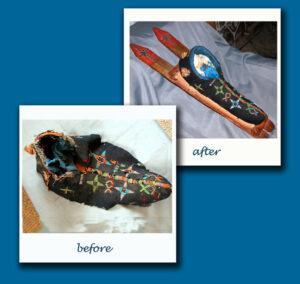Ancient Artways Conservation LLC specializes in the preservation of ethnographic art objects, with a special emphasis on historic Native American art and cultural materials. Serving the needs of the private collector as well as larger institutional collections and museums, we offer a full range of conservation services that include treatments, condition assessments, collections care consulting, lighting and exhibit design, and conservation analytical services.
Who are We?
Ancient Artways founder Nancy Fonicello has been involved with ethnographic art for over 40 years. She is widely known for her expertise on Native American porcupine quillwork, beadwork, and other native traditional arts. With formal background in environmental chemistry and hands-on training in some of the most respected museums and conservation laboratories in the country, she offers a unique perspective on the preservation of ethnographic and material culture collections.
Please visit our pages to learn more about the preservation work here at Ancient Artways Conservation.

Before and After treatment of a toy cradleboard
What is Conservation?
Conservation is the practice of applying scientific, technical, and historical analysis to the preservation and study of art and artifacts. The term ‘conservation’ is sometimes used interchangeably with the term ‘restoration’. Restoration can indeed be part of preserving an art object, but conservation encompasses much more than simply attempting to bring cultural property back to it’s original appearance. It is an interdisciplinary approach which incorporates art, scientific analysis, historic research, and material science to document, stabilize, and preserve historic artifacts.
Conservation also focuses on using preventative measures to inhibit on-going or future deterioration of the object or its components. By selecting methods and materials that do not adversely affect an object’s original materials, professional conservation treatments do not impede future examination or scientific analysis, nor adversely impact the functionality of the object. When working with ethnographic and archeological material, it is important to remember that an object’s history and evidence of use can be as significant as the object itself. Conservators work with the objective of preserving as much evidence of an object’s life history as possible to allow it to be understood and interpreted in the wider cultural context.
